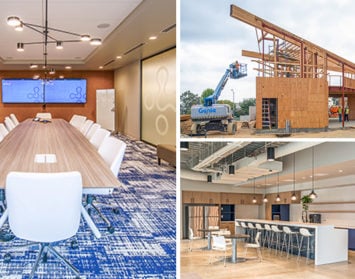Whether your company is poised to triple its staff within two years or it is already bursting the seams of your current office space, sometimes you have no choice but to expand. In a perfect world, you’d just pack up and move right into a brand new space that is designed exactly the way you want it. However, for most businesses, that option is not available. Instead, in order to keep your company operational, a phased construction plan to expand is most likely going to be necessary.
A phased construction expansion is a complex process, so you’ll want to go into it with realistic expectations in order to mitigate unexpected surprises (often in the form of delays), hidden expenses, and lost production along the way. From weighing the impacts that the office expansion will have on your organization’s operations, to understanding the cost premiums inherent in phased construction projects, there is a whole lot more than meets the eye when it comes to expanding your business in phases.
Here’s a look at what to expect when planning to expand your business into adjacent space or neighboring buildings.
Realistic Impacts on Your Organization
If your current real estate lease prevents you from expanding in any other way than phased construction, there will be an impact on your company’s operations. Potential disruptions include the need to relocate/protect your server room and finding solutions to parking challenges if site work takes up a chunk of your parking. You will also need to have a plan for keeping employees safe during construction and ensuring shipping, receiving, and manufacturing spaces are uninterrupted over the course of the project.
Be aware that employees will likely be dealing with added distractions and noise, which can reduce efficiency. In addition, you may need to simultaneously plan for a redesign of your current space, so that it matches (aesthetically and/or functionally) with the new space. You will also need to coordinate a hyper-specific move-in plan in order to minimize workflow delays.
Cost Premiums
Phased build-outs will come at a higher cost than other construction/renovation projects. Because you’re expanding in phases, design and construction efficiency decrease as you have a construction set for each phase, and sometimes a separate permit per phase. In the meantime, your construction project schedule will increase, meaning you’ll pay a premium. Some of the many reasons for increased design and construction costs include:
- Additional construction administration time needed from designers due to the lengthened project schedule.
- Increased number of design meetings and design documents required due to each phase being its own ‘mini’ project within the overall program.
- Potential for increased permitting and inspection fees from local authorities if each phase is permitted separately.
- Lengthened construction schedule resulting in additional costs for general conditions and jobsite requirements.
- Decreased efficiency amongst all trades (electrical, plumbing, etc.) due to more confined workflow.
- Additional subcontractor costs for mobilization and layout of each phase.
- Premiums for shipping multiple deliveries and for storage due to the need to procure materials while they are still readily available.
- Additional costs for temporary barricades and delineation to separate construction work from employee space to ensure safety and minimize distractions.
- Potential costs for temporary HVAC, electrical, or plumbing equipment during shutdowns or cut-overs of the building systems.
- Potential costs to relocate building systems or keep building systems live during relocation.
There is little doubt that most companies would prefer a one-shot-deal, allowing them to move into an entirely new office all at once, rather than expanding their existing space in phases. Unfortunately, this option is rarely on the table. To save yourself a headache and allay the stress associated with a phased construction project it is highly advisable to bring an experienced construction manager on board to oversee all the details and planning.
In addition to helping you to ascertain realistic impacts to your organization, Hughes Marino’s Construction Management team is experienced in educating companies on the price they will actually pay for phased construction of their office spaces. With a CM on your team you can be sure that you’re making budget-driven decisions from the very start, which will save you time and money when all is said and done.
Hughes Marino’s industry leading Construction Management team has unmatched expertise in every type of commercial building project from tenant improvements to ground-up build-to-suits. With decades of experience in California and beyond, our project managers, engineers and LEED APs offer practical insights for the construction management professional.











